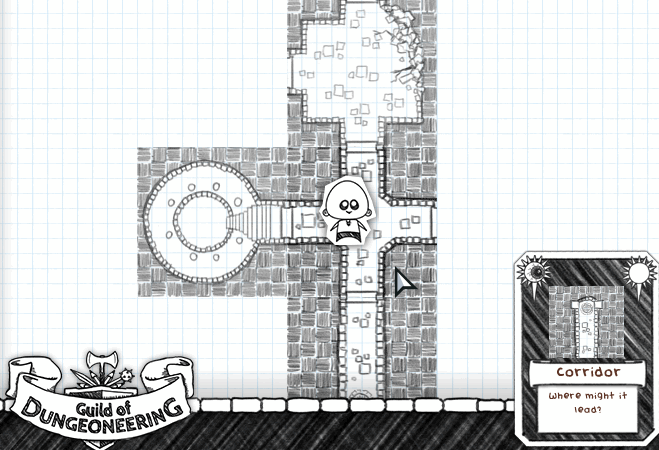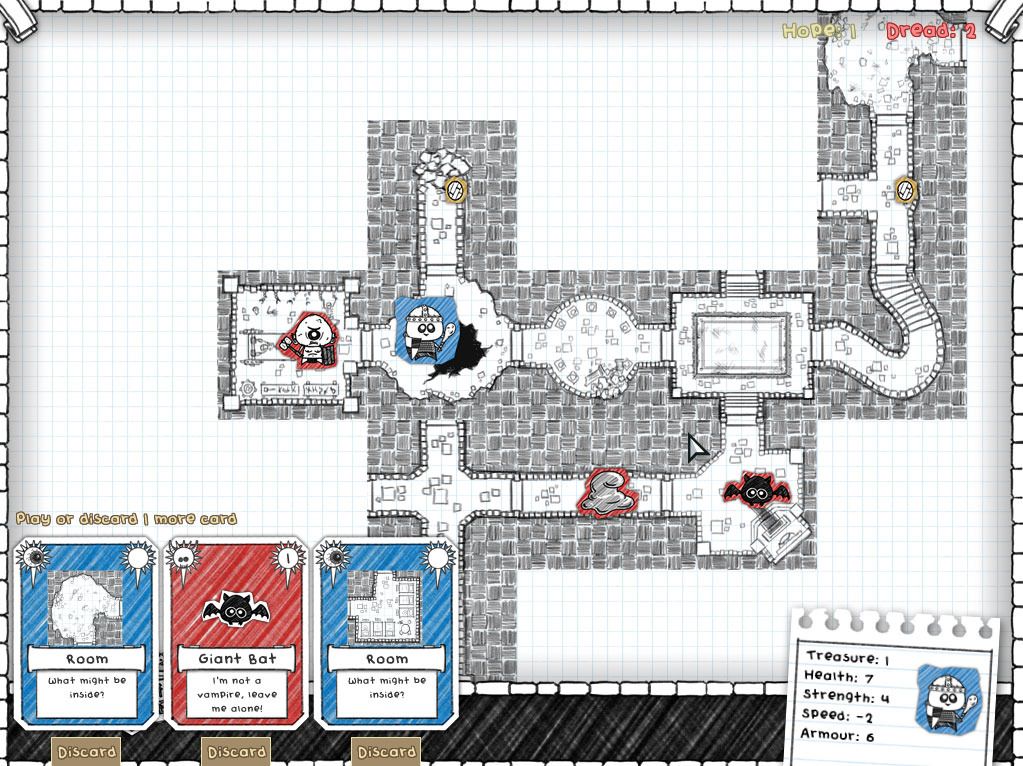
Game code provided by PR
Arguably, the best thing about pen and paper RPGs is the group of people you play with, closely followed by the fluid and dynamic nature of each game that builds as you go along. Whilst videogames have done a superb job of completely killing the social aspect of these games, they’ve done lots when it comes to mapping out your quest as you play it. Guild of Dungeoneering goes even further than most, allowing you to build and populate a dungeon for an AI hero to conquer.
The first thing that will hit you in the face like a +10 enchanted mace is the beautiful style the game flaunts. It seems so simple, with your dungeon starting off as a near-enough plain piece of graph paper. This is old school pen and paper RPG territory and a great throwback for any fans of pre-screen RPG adventures. Everything looks like it has been hastily scribbled with a pencil, from the characters to the dungeons and even the text, making it visually distinct to anything else out there. And the graphics aren’t the only refreshing part of the experience either.
At its core, Guild of Dungeoneering is a dungeon builder, but it’s unlike other games in this niche genre. Whereas most dungeon builders encourage you to lay traps to mash and smash curious heroes, this time you’re building a dungeon that encourages looting and plundering. You can place corridors, monsters and sweet, sweet loot, all of which helps to guide your plucky NPC hero through the dank halls and dimly lit rooms you’ve laid out. If you build a chamber and make it worth visiting by dropping a piece of loot at its centre, your hastily drawn character will happily trundle along to investigate, which can be to their peril if you’ve put down a particularly nasty monster too.

The game generally has two parts to each turn, the placement phase and the action phase. During placement you’re presented with a hand of five cards with either a dungeon part, creature or piece of loot printed on it. Drag and drop dungeon parts to expand the sprawling lair ahead of your adventurer, then put down loot and monsters to fill the areas. Your hero will automatically charge towards the best looking location, whether that’s a piece of loot or a lowly-looking piece of dungeon monster meat to swipe at. When a creature is encountered the battle mode begins.
Combat is played out with a very simple yet quite addictive card battling game. At the start of your turn you’re presented with three cards, each one with a different type of action. It might deal damage, block, counter or add a number of other little twists. The kicker is that you can see the action the enemy AI is going to make, challenging you to pick the best counter move to win the battle. It’s a fun system that makes you think a tad strategically instead of spamming attacks.
After your foe is toppled you’re rewarded with XP to boost your stats as well as an item of loot. Rather than a sword that gives your general attacks more heft or other usual buffs, equipment in Guild of Dungeoneering adds additional cards and abilities to your attack deck. So whereas your normal cards may only allow you to deal up to two damage, a sword may slip a card into your hand that allows you to deal three damage. Again, it’s a new take on loot and equipment that fits in with the pen and paper RPG feel brilliantly.

But it’s not just about having an aimless jolly around a dark dungeon. In the build that we played, our adventurer was tasked with striking down the dungeon boss. The only snag was that we didn’t have a route to him yet, meaning we had to sculpt a path and fill it with loot and monsters along the way, allowing us to suitably level up. It’s a great idea, but one that started to lead to a few frustrations along the way.
The main issue is that the cards you use to build the dungeon are drawn at random. This means that you can get nothing but dead ends and left turns, which is a huge pain when you need to grow your dungeon in the opposite direction to reach a pre-placed boss or treasure room. In the one level available to preview, the boss has a ten turn countdown timer before he gains an HP buff and becomes a little too powerful to strike down. Therefore, to beat him you can’t really fanny about building a winding, twisting dungeon of intrigue, but are better off building a straight corridor. This random layout mechanic adds a fun flavour to the format, but makes it a little maddening when you’re working towards a specific location.
Another feature that’s still under construction is the ability to build a guild. The full game will keep track of your progress, recording the gold and gear you bring back from your custom dungeons. This gold can in turn be used to upgrade your guild, which branches out and builds up in a similar way to the dungeons. A better guild attracts more dungeoneers to your doors, allowing you to acquire adventurers along the way who are a little more capable at hack and slash.
Even though it’s still in the early stages, Guild of Dungeoneering looks very promising. The demo scenario we played is great fun and could grow into an amazing turn-based game that’s unlike anything else we’ve played before. It’s obviously still in its early stages, but with a little more love and a few more scenarios built into it, this could be a real hit with near unlimited replay value due to completely randomised dungeons that you build. The card combat feels like it could do with a bit of fleshing out, but we’re sure that’s up in the air with the other development bits.







Comments